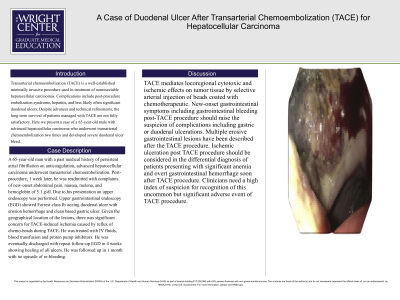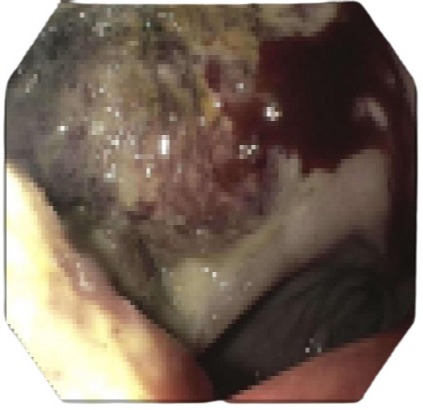Tuesday Poster Session
Category: GI Bleeding
P3526 - A Case of Duodenal Ulcer After Transarterial Chemoembolization (TACE) for Hepatocellular Carcinoma
Tuesday, October 24, 2023
10:30 AM - 4:00 PM PT
Location: Exhibit Hall

Has Audio

Khalid Ahmed, MD
The Wright Center for GME
Scranton, PA
Presenting Author(s)
Khalid Ahmed, MD1, Syed Muhammad Hussain Zaidi, MD2, Elmkdad Mohammed, MD1, Peter Iskander, MD3, Osama Hamid, MD, MRCPI4, Manasik Abdu, MD5, Udit Asija, MD1, Sandeep Mandal, MD1, Beshir Saeed, MD6, Abhinav Goyal, MD7
1The Wright Center for GME, Scranton, PA; 2Wright Center, Scranton, PA; 3The Wright Center for GME, Dunmore, PA; 4Cleveland Clinic, Cleveland, OH; 5University at Buffalo-Catholic Health System, Buffalo, NY; 6Jefferson Lansdale Hospital, Lansdale, PA; 7Geisinger Community Medical Center, Scranton, PA
Introduction: Transarterial chemoembolization (TACE) is a well-established minimally invasive procedure used in treatment of nonresectable hepatocellular carcinomas. Complications include post-procedure embolization syndrome, hepatitis, and less likely often significant duodenal ulcers. Despite advances and technical refinements, the long-term survival of patients managed with TACE are not fully satisfactory. Here we present a case of a 65-year-old male with advanced hepatocellular carcinoma who underwent transarterial chemoembolization two times and developed severe duodenal ulcer bleed.
Case Description/Methods: A 65-year-old man with a past medical history of persistent atrial fibrillation on anticoagulation, advanced hepatocellular carcinoma underwent transarterial chemoembolization. Post-procedure, 1 week later, he was readmitted with complaints of new-onset abdominal pain, nausea, melena, and hemoglobin of 5.1 g/dl. Due to his presentation an upper endoscopy was performed. Upper gastrointestinal endoscopy (EGD) showed Forrest class Ib oozing duodenal ulcer with erosion hemorrhage and clean based gastric ulcer. Given the geographical location of the lesions, there was significant concern for TACE-induced ischemia caused by reflux of chemo-beads during TACE. He was treated with IV fluids, blood transfusion and proton pump inhibitors. He was eventually discharged with repeat follow-up EGD in 4 weeks showing healing of all ulcers. He was followed up in 1 month with no episode of re-bleeding.
Discussion: TACE mediates locoregional cytotoxic and ischemic effects on tumor tissue by selective arterial injection of beads coated with chemotherapeutic. New-onset gastrointestinal symptoms including gastrointestinal bleeding post-TACE procedure should raise the suspicion of complications including gastric or duodenal ulcerations. Multiple erosive gastrointestinal lesions have been described after the TACE procedure. Ischemic ulceration post TACE procedure should be considered in the differential diagnosis of patients presenting with significant anemia and overt gastrointestinal hemorrhage soon after TACE procedure. Clinicians need a high index of suspicion for recognition of this uncommon but significant adverse event of TACE procedure.

Disclosures:
Khalid Ahmed, MD1, Syed Muhammad Hussain Zaidi, MD2, Elmkdad Mohammed, MD1, Peter Iskander, MD3, Osama Hamid, MD, MRCPI4, Manasik Abdu, MD5, Udit Asija, MD1, Sandeep Mandal, MD1, Beshir Saeed, MD6, Abhinav Goyal, MD7. P3526 - A Case of Duodenal Ulcer After Transarterial Chemoembolization (TACE) for Hepatocellular Carcinoma, ACG 2023 Annual Scientific Meeting Abstracts. Vancouver, BC, Canada: American College of Gastroenterology.
1The Wright Center for GME, Scranton, PA; 2Wright Center, Scranton, PA; 3The Wright Center for GME, Dunmore, PA; 4Cleveland Clinic, Cleveland, OH; 5University at Buffalo-Catholic Health System, Buffalo, NY; 6Jefferson Lansdale Hospital, Lansdale, PA; 7Geisinger Community Medical Center, Scranton, PA
Introduction: Transarterial chemoembolization (TACE) is a well-established minimally invasive procedure used in treatment of nonresectable hepatocellular carcinomas. Complications include post-procedure embolization syndrome, hepatitis, and less likely often significant duodenal ulcers. Despite advances and technical refinements, the long-term survival of patients managed with TACE are not fully satisfactory. Here we present a case of a 65-year-old male with advanced hepatocellular carcinoma who underwent transarterial chemoembolization two times and developed severe duodenal ulcer bleed.
Case Description/Methods: A 65-year-old man with a past medical history of persistent atrial fibrillation on anticoagulation, advanced hepatocellular carcinoma underwent transarterial chemoembolization. Post-procedure, 1 week later, he was readmitted with complaints of new-onset abdominal pain, nausea, melena, and hemoglobin of 5.1 g/dl. Due to his presentation an upper endoscopy was performed. Upper gastrointestinal endoscopy (EGD) showed Forrest class Ib oozing duodenal ulcer with erosion hemorrhage and clean based gastric ulcer. Given the geographical location of the lesions, there was significant concern for TACE-induced ischemia caused by reflux of chemo-beads during TACE. He was treated with IV fluids, blood transfusion and proton pump inhibitors. He was eventually discharged with repeat follow-up EGD in 4 weeks showing healing of all ulcers. He was followed up in 1 month with no episode of re-bleeding.
Discussion: TACE mediates locoregional cytotoxic and ischemic effects on tumor tissue by selective arterial injection of beads coated with chemotherapeutic. New-onset gastrointestinal symptoms including gastrointestinal bleeding post-TACE procedure should raise the suspicion of complications including gastric or duodenal ulcerations. Multiple erosive gastrointestinal lesions have been described after the TACE procedure. Ischemic ulceration post TACE procedure should be considered in the differential diagnosis of patients presenting with significant anemia and overt gastrointestinal hemorrhage soon after TACE procedure. Clinicians need a high index of suspicion for recognition of this uncommon but significant adverse event of TACE procedure.

Figure: Figure 1. Oozing duodenal ulcer
Disclosures:
Khalid Ahmed indicated no relevant financial relationships.
Syed Muhammad Hussain Zaidi indicated no relevant financial relationships.
Elmkdad Mohammed indicated no relevant financial relationships.
Peter Iskander indicated no relevant financial relationships.
Osama Hamid indicated no relevant financial relationships.
Manasik Abdu indicated no relevant financial relationships.
Udit Asija indicated no relevant financial relationships.
Sandeep Mandal indicated no relevant financial relationships.
Beshir Saeed indicated no relevant financial relationships.
Abhinav Goyal: Moderna – Stock-publicly held company(excluding mutual/index funds). Pfiezer – Stock-publicly held company(excluding mutual/index funds).
Khalid Ahmed, MD1, Syed Muhammad Hussain Zaidi, MD2, Elmkdad Mohammed, MD1, Peter Iskander, MD3, Osama Hamid, MD, MRCPI4, Manasik Abdu, MD5, Udit Asija, MD1, Sandeep Mandal, MD1, Beshir Saeed, MD6, Abhinav Goyal, MD7. P3526 - A Case of Duodenal Ulcer After Transarterial Chemoembolization (TACE) for Hepatocellular Carcinoma, ACG 2023 Annual Scientific Meeting Abstracts. Vancouver, BC, Canada: American College of Gastroenterology.
